Nuggets of News Blog
|  |
Thursday, October 28 2021
Available through December 31, 2021 only... Garrett is offering two special packages for Fall 2021 featuring the AT Max metal detector. Either package you choose is $722.46 with FREE SHIPPING -- a savings of $181.85 if items purchased separately.
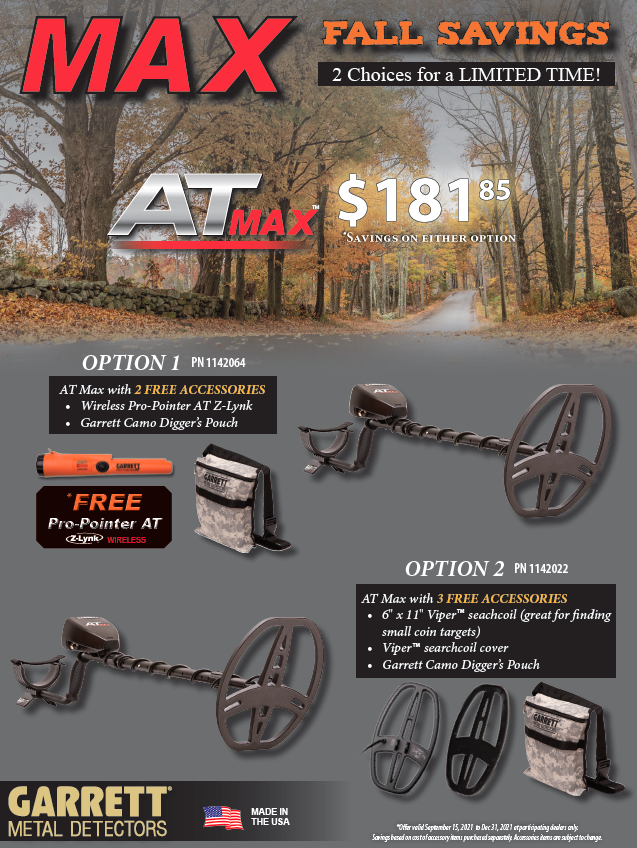
The ALL TERRAIN Garrett AT Max metal detector is designed for dusty, humid or wet environments. Fully waterproof to 10 feet. Enhanced electronics, a 13.6 kHz operating frequency, and eight Sensitivity/Depth adjustments allow you to detect targets deeper than other Garrett AT detectors. The Garrett exclusive Automated Ground Balance Window feature can simultaneously "spread" the ground balance setting to a range of values to reduce ground response in severely mineralized areas. Automatic and manually adjustable ground balance options also available. Superfast Z-Lynk wireless technology is 6 times faster than Bluetooth. Integrated circuitry transmits audio to your wireless headphones. Auto pairing. No cables, and no interference from other wireless devices. Hunt Day or Night with the backlit display feature that allows you to continue hunting in low light conditions. The Iron Audio feature allows you to hear iron trash before you dig it! Also includes True All Metal Mode, All Metal Iron Mode, Digital Target ID and Adjustable Threshold to better hear targets.
Thursday, October 21 2021
Do you work on a small gold mining crew that’s relatively new to the mining world? Would you be happy to be filmed while you work?
Raw TV, the producers of the Discovery Channel's popular TV show GOLD RUSH -- starring Parker Schnable, Rick Ness, Fred Lewis and Tony Beets -- is looking for the next generation of gold miners to appear on a new TV show! Gold Rush is a reality television series that follows the placer gold mining efforts of various family-run mining companies, mostly in the Klondike region of Dawson City, Yukon, Canada. The show is in its 12th season as of 2021.
A producer at Raw TV in London would like to hear from miners who work on a placer gold mining operation based anywhere in the lower 48 states, Alaska, Yukon or British Columbia, who would be happy to filmed as part of a brand new TV show. The producers are looking for people who have been mining for at least one season and have a crew of at least three. You would need to have an existing camp set up with your own heavy equipment in place including wash plant, excavator etc.
If you, or anyone you know, might be interested, get more information and complete the online form before February 28, 2022 at: https://www.raw.co.uk/takepart/2387
Are you relatively green to the mining game and hungry for gold? Do you know any young guns out there who are mining? Or any old-time miners whose son or daughter is setting up their own small operation? If so, this just might be the fun opportunity of a life-time! Given the popularity of Gold Rush, numerous "aftershows" and specials and spin-offs have been produced that document behind-the-scenes action featuring additional footage, as well as studio interviews with miners and crew. Some of these spin-offs include:
- Gold Rush: White Water series follows the "Dakota Boys"—Dustin and his father, "Dakota" Fred—as they mine McKinley and Cahoon Creeks in Haines Borough, Alaska, using an unconventional dredging method: diving into whitewater collection pools at the base of high country waterfalls.
- Gold Rush: Dave Turin's Lost Mine follows Dave Turin, formerly of the Hoffman crew, as he looks to start new mining operations at disused gold mines in the Western United States.
- Gold Rush: Parker's Trail followed Parker Schnabel on trips to other countries such as Guyana, Papua New Guinea, and Australia.
- Gold Rush: Winter's Fortune featured Tony Beets, Rick Ness, Dave Turin, Fred Lewis, and Dustin Hurt starting their off-season prospecting, scouting, and preparing for the 2021 season.
- Hoffman Family Gold is a new standalone series that will premiere in February 2022, focused on Todd Hoffmann's return to gold mining. It will take place 100 miles north of Nome, Alaska and will include his father, Jack, and son, Hunter.
As you can see, gold mining spin-off shows are plentiful and now might be YOUR turn to become a gold mining TV celebrity! If you, or anyone you know, might be interested, get more information and complete the online form before February 28, 2022 at: https://www.raw.co.uk/takepart/2387
Friday, October 01 2021
Sluicing is one of the most popular gold-recovery methods, and a sluice box is often a miner’s first purchase after a basic gold pan. There are many options to consider— riffles, matting, brands, and sizes. You might want to stick with traditional z-riffle sluices with ribbed matting and miner’s carpet, try the new mini or vortex Dream Mats without riffles, or a combination of different types of miner’s moss. No matter what you choose or upgrade to, sluicing techniques are fairly straight forward. The three main things to concentrate on for best gold capture are: proper selection and set up, material classification and processing, and monitoring. These three key steps will allow you to maximize gold recovery. 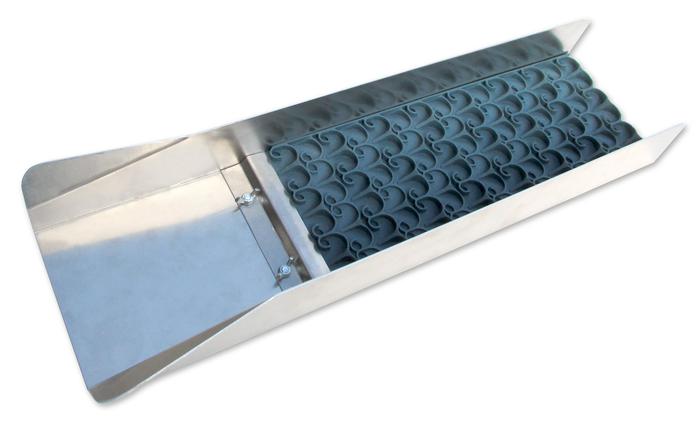
Proper Set Up. This is by far the most important aspect of gold separation and recovery and includes angle, horizontal leveling, and water flow. Improper sluice angle is probably the most common error most miners make. The old rule of thumb of setting your sluice to “one inch per foot” is just a starting point and can result in too much water velocity. Too much water leads to improper breakdown and separation of heavy concentrates and material moving through the box too quickly, which can mean loss of fine gold. A Sluice Setter Digital Pitch Gauge can help, and so can focusing on water velocity instead of just the angle. Try the “one second per foot” method. Measure 12 inches down your sluice and mark that spot. As you feed material into your sluice using a side-to-side motion, count “one thousand one.” Your material should be passing the 12 inch mark as you finish that count. If it needs to be faster, increase the rear angle. If it needs to be slower, decrease the rear angle. As material travels down the sluice, be sure you are utilizing the entire capture area. If material is being forced to one side or the other, leaving one side clogged with too much material, while the other side is not processing at all, it could mean the sluice is not properly leveled horizontally.
Material Classification and Processing. In order to capture small gold in quantity, finer classification is usually necessary, even though it’ll take more time to do so. Processing speed and the volume of material to put into the sluice (by hand or by scoop) must be matched to the volume and velocity of the water. If too much material is introduced into the flow, the water velocity will slow down causing the sluice to back up and lose gold. Gradually add smaller amounts of material to the flow using a wide scoop.
Monitoring Your Sluice. When using stream flows, you are bound by the characteristics of that waterway—water speed, depth, and the ability to change your sluice angle. Mechanical flow is not limited by nature since you can control it. But no matter who is controlling the water (you or Mother Nature) monitor two factors while running gold-bearing material: how the sluice is processing the material, and the capacity of your sluice. How much can the sluice hold before it loses the ability to separate heavy materials and capture gold? If you see movement of heavy material down the sluice or movement of captured gold, it’s time to remove your sluice from the river, clean it, and reset it. When processing difficult material, set up a regular cleaning schedule so you don’t lose gold.
Applying these three main techniques while sluicing — proper selection and set up, material classification and processing, and monitoring — will allow you to adapt to changing conditions no matter the type or brand of sluice box you prefer. And remember that old saying "practice makes perfect" — using the same gold-bearing paydirt over and over again means you can learn these techniques and tips much quicker and recover more gold!
Wednesday, June 30 2021
Millions of viewers admit that their guilty pleasure is watching the TV show "Gold Rush" on the Discovery Channel. Every Friday night 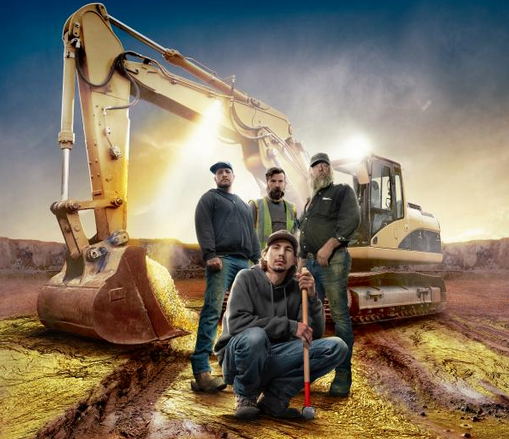 for over a decade now, viewers have been enlightened and entertained by Gold Rush, Bering Sea Gold, White Water, and a couple of newer shows— Dave Turin's Lost Mine and Freddy Dodge's Mine Rescue. Although they’re off the air now, Under the Ice and Jungle Gold also captured attention a few years back. Aussie Gold Hunters is also interesting, and takes place in Western Australia. for over a decade now, viewers have been enlightened and entertained by Gold Rush, Bering Sea Gold, White Water, and a couple of newer shows— Dave Turin's Lost Mine and Freddy Dodge's Mine Rescue. Although they’re off the air now, Under the Ice and Jungle Gold also captured attention a few years back. Aussie Gold Hunters is also interesting, and takes place in Western Australia.
Thanks to these reality TV shows, you’ll get to know more about Parker Schnabel, Rick Ness, Tony Beets, Dakota Fred, Emily Riedel, and Shawn Pomrenke than your own next door neighbors! And the scenery just can’t be beat either. Whether it’s the wide open spaces in Montana, Colorado and Arizona, or the snow-covered mountains of Alaska and the Yukon, the mining locations are nothing short of spectacular. Who wouldn’t want those views from their workplace every day?!
Reality television can be a compelling and very influential form of entertainment. It shows real people, real experiences (with some “Hollywood” thrown in) and viewers somehow relate to them, especially to the “stars” you either love or love to hate. The challenges of inter-miner-relationships that unfold in front of the viewing public can remind you of your own family dynamics, too. That being said, can you actually LEARN anything VALUABLE about gold mining by tuning in?
The answer is YES — especially when things go wrong. Seeing how a “gold guru” solves problems can teach all of us a thing or two about dealing with equipment failures, bad weather, uncooperative government agencies, and team dynamics. Although you may never run 300 yards of material an hour at your own mine site, if a belt tears, you can get a basic understanding of how to fix it thanks to the various repairs you see being performed by the crews on TV. Muddy water running over your sluice? Watch how the experts evaluate their pump and settling pond to get clear water flowing again. Finding gold in your tailings? Maybe the water flow is too fast or the riffles aren’t deep enough and gold is being washed out. When you see a miner stuck in the middle of nowhere without a replacement part, you just might remember to take along extras on your next trip. You’ve probably struggled with the pitch on your highbanker, and had to rely on duct tape a time or two. The celebrity miners face the same challenges, only on a much larger scale. And no matter who you are, some days you just don’t find gold, or perhaps not enough to pay for your fuel and other expenses.
Perhaps the most important lesson to take away from these TV shows is about pivoting. If the ground or stream you’re working doesn’t produce, despite the time and trouble you’ve already invested, re-think your strategy. Another valuable nugget you can take away from reality TV gold shows is preparation.

Do your research first. Successful miners don't just go out and find a random chunk of land and start digging. They review geological maps, talk to experts and test soil samples first. Before they start they already have a pretty good idea that they will find gold where they dig. They just don’t know how much they’ll find and how much effort and time it will require to get it out of the ground. The Bureau of Land Management’s new Mineral Land Records System (MLRS) is a geospatially enabled online land information system that allows miners to more readily research land status, discover mining claim activity, file new claims, pay fees, and more. And don’t forget good old-fashioned library research, too.
Plan for repairs. The heavy equipment used for gold mining includes bull dozers, dump trucks, and wash plants. The miners have teams of people that have the expertise to run and repair the equipment. Much of the drama on the Gold Rush shows occurs when their equipment breaks down. Even if all you are using is a shovel, stream sluice, and gold pan, you can’t find gold if your equipment is not up to snuff. Take extra sluice box matting and a few sizes of classifiers and pans on your next trip. If you just bought a Gold Cube or Desert Fox spiral panning machine, for example, set it up and learn to use it at home first. Become familiar with how a metal detector works before you try and use it in the field.
Be productive. Gold miners generally have a short season in which to find gold. They start when the ground thaws or the ice melts, and their season ends with the first winter snow. Consequently, they must make every minute count. Your operation might not be 24 hours per day, 7 days per week like on TV, but if you get the research done during winter down-time, you can hit the ground running in the spring and summer. If you test your equipment before you use it for the first time, you won’t be slowed down by surprise repairs quite as often.
Gold mining is a challenge, but as long as you’re reasonable with your expenditures and your expectations, it’s a heck of a lot of fun in the great outdoors. And it also gets you off the couch… just remember to record those reality shows so you can watch them at a later date when you’re not out in the gold fields "making it happening" as Gold Rush’s Tony Beets likes to say! Good luck!
A brief description of the Discovery channel’s most popular gold shows:
Gold Rush. The series follows the placer gold mining efforts of various family-run mining companies, mostly in the Klondike region of Dawson City, Yukon, Canada. Parker Schnabel, Rick Ness, and Tony Beets are the celebrity miners we’ve watch for 11 seasons.
White Water. Back where their gold-mining adventures began, `Gold Rush' alumni Dakota Fred and son Justin persevere in the face of long odds, risking their lives for a fortune they may never realize. Assisted by a team of intrepid divers, mountaineers and bush mechanics, the Dakota Boys explore the white water rapids of McKinley Creek in Alaska, diving deep in raging torrents with a suction dredge. Not only could one wrong move prove deadly, but the guys also face wild animals, extreme temperatures and hypothermia.
Bering Sea Gold. The gold rush in Alaska isn't confined to the state's precious ground. It's taking place on the sea ... or more accurately, on the bottom of the frigid Bering Sea. This series follows several gold dredges of all shapes and sizes, and their eccentric and driven crews who risk their lives to find as much gold as possible before winter sets in and it's too dangerous to dive.
Dave Turin's Lost Mine. Dave Turin spent years working alongside Todd Hoffman, earning the nickname `Dozer Dave' because of the many hours he spent bulldozing for gold. In this show, Dave is his own boss, and he's on a mission to find an abandoned mine to resurrect in the hope that old-timers left gold behind. He explores the history of each mine, a search that culminates in Dave picking the one that he can turn into newfound riches.
Freddy Dodge's Mine Rescue. A gold mining veteran with more than 40 years of mining under his belt, Freddy Dodge has earned the name “Gold Guru.” In each episode, Freddy “rescues” various small-time mining operations. He reveals hard-earned practical knowledge about where to look for gold as well as perfecting the miners’ equipment and techniques. He is joined on the show by expert mechanic and former Gold Rush miner Juan Ibarra.
Tuesday, June 01 2021
The Bureau of Land Management (BLM) is responsible for managing approximately 245 million acres of Federal surface estate and 700 million acres of subsurface mineral estate. In the past, miners would have accessed the BLM’s Legacy Rehost system, commonly known as LR2000, to do research. While helpful, that system was also frustrating to use, so you’ll be happy to know that LR2000 has been decommissioned and the NEW Mineral Land Records System (MLRS) has taken its place.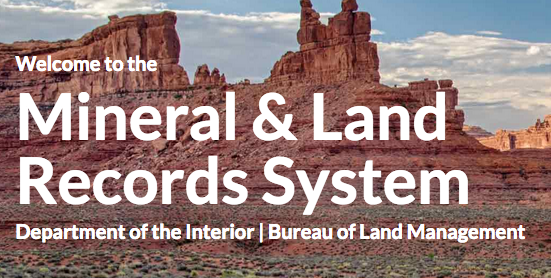
MLRS is a geospatially enabled online land information system that allows miners to more readily research land status, discover mining claim activity, file new claims, pay fees, and more. Signing up for a MLRS account is useful if you have business with the BLM involving mining claims. MLRS is free to use, and there are no additional fees to create an account.When you sign up for an MLRS account, you get access to several useful tools that will enhance your BLM experience— file and manage your claims, receive real-time status updates, access advanced mapping tools, and interact with the BLM online.You should register with MLRS if you are a:
• Recreational miner
• Small mining business owner
• Large mining corporation employee
• Mining association member
• Person who is interested in bookmarking research maps or saving your search results
Your account type is determined by your needs.
• Create a personal account if you own your claims as an individual and will be the only user within the account.
• Create a business account if your claims are owned by a business, you plan to add employees to the account, and/or you will be using a business email.
As the capabilities of MLRS grow in the future, an even wider range of mission-critical BLM services and products such as permits, leases, rights-of-way, the ability to provide electronic signatures on documents, and more will be available. In the meantime, check out the new system that offers state-of the-art mineral and land records transactions, tracking, and mapping. With the new system, you’ll get your research done much faster than using topo maps, and that means more boots-on-the-ground prospecting time this summer!
Sunday, April 25 2021
Depending on where you live, spring is in the air, either a little or a lot. What that mostly means is we're all getting out and about more to prospect for gold, metal detect, and just clean up around our property. Especially as restrictions from Covid-19 are lifted, we’re hankering to get out and have fun. In general, springtime ushers in rain, warmer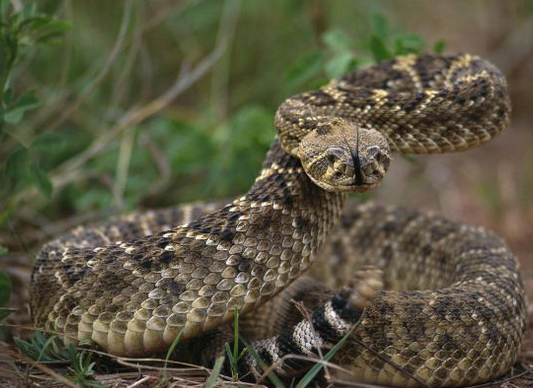 temperatures, and blooming flowers. You can add something else to that list: snakes. temperatures, and blooming flowers. You can add something else to that list: snakes.
Snakes love warmer days. As reptiles, their body temperature mirrors air temperature, so it’s common to begin seeing many more snakes this time of year. And that means spring is also a good time to be extra vigilant about where you step and sit. Most rattlesnake bites occur when you accidentally step on or near a snake and startle it. That’s easy to do when you’re zoning out swinging a detector or hiking in tall grass toward your favorite gold-bearing river. When you are otherwise distracted by gold fever or a chore (stacking wood, cleaning out your shed, landscaping), you might not be thinking about where you’re putting your hands and feet.
People have a lot of fear about snakes and think they’re dangerous. If you are harassing a rattlesnake or trying to grab one and they bite you, yes, they can be dangerous. But if you leave them alone, they are not purposely going to attack you. After all, a snake uses its venom for food, not for defense. Most snakes are not outwardly aggressive unless provoked or startled. Some snakes, such at the cottonmouth, are known to be more aggressive than others, but again, that’s only when harassed.
Keep in mind that snakes of many species are done hunkering down now that the weather is warmer, making human encounters more likely with ALL types of snakes. You might even see snakes in more northern areas where you’ve not seen them before. In general, rattlesnakes are most active from March through October. In the spring, they are active during daylight hours. As days become increasingly hot around early May, rattlesnakes become more active at night and spend the day in a spot of shade or a cool shelter.
If you are bitten by a snake, the Mayo Clinic advises:
• Call 911 immediately or get yourself to a hospital as quickly as possible.
• While waiting for medical help, stay calm and position the body so that the bite is at or below heart level.
• Remove jewelry or tight clothing before swelling starts.
• Do NOT apply ice or a tourniquet on or near the bite.
• Do NOT cut the wound or attempt to suck out the venom.
• Do NOT drink caffeine or alcohol, which could speed the body's absorption of venom.
As you venture outside this spring and summer, help protect your lower legs with snake gaiters— they also help protect against thorns, briars, and cacti needles. If you've ever brushed against them by accident, you know how painful that can be! Snake leggings are used by the US Border Patrol, US Forestry Service, hunters, hikers, fishermen, ranchers, surveyors, realtors, landscapers, and thousands of treasure hunters who need protection for lower legs. Don’t take a chance! Take precautions to be safe this season— whether in the desert or woods — by adding snake gaiters to your list of “must have” equipment.
Monday, March 15 2021
Spring is in the air, and Garrett is making it a little easier on your wallet to get out there and start swinging a new metal detector! For a limited time, Garrett is offering two specially-priced packages. Each package includes a metal detector, headphones, an AT Pinpointer, and Garrett Edge Digger. You save $134.90 on a package as compared to buying each component separately. Both packages have FREE SHIPPING, too!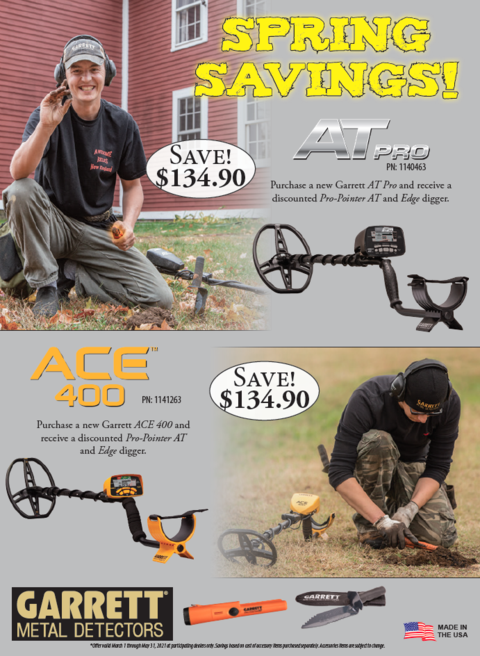
Garrett AT Pro Metal Detector and Headphones. The AT Pro is Garrett's all-terrain, all-treasure, deep-seeking, professional treasure hunter's detector! This all-terrain detector offers new and exclusive Garrett technology that makes highly recommended for Coin Hunting, Jewelry Hunting, Relic Hunting, Cache Hunting, Prospecting, Ghost Town Hunting, Competition Events, Beach/Fresh Water Hunting. Select from either Standard or Professional search modes with enhanced audio features. The AT Pro was designed to work in challenging environments such as mineralized ground, high trash areas, wet and humid areas and dust. In fact, the entire metal detector can be submerged under water to a dept of 10 feet, so it's an excellent choice for detectorists who might also be gold prospectors working in streams, ponds, or shallow water off the shoreline. Includes upgraded MS-2 headphones, Pro-Pointer AT Pinpointer and Garrett Edge Digger. Details on AT Pro Spring 2021 package here.
Garrett ACE 400 Metal Detector and Headphones. The top of the ACE family, the 400 has a new Iron Audio feature, a powerful DD coil, a higher frequency, and volume control headphones. Its advanced features make the ACE 400 powerful on coins, jewelry, and artifacts. Features a 8.5” x 11” PROformance DD submersible searchcoil. Comes with Pro-Pointer AT Pinpointer, Garrett Edge Digger, and ClearSound Easy Stow Headphones that feature padded ear pieces, 41 inch coiled cord extends to 82 inches, and 1/4 inch phone plug. Details on ACE 400 Spring 2021 package here.
Metal Detectorist Code of Ethics
- Always check federal, state, county and local laws before using your metal detector. It is your responsibility to “know the law.”
- Abide by all laws, ordinances or regulations that may govern metal detecting in the area you will be in.
- Never trespass. Always obtain permission prior to entering private property, mineral claims, or underwater salvage leases.
- Do not damage, deface, destroy, or vandalize any property (including: ghost towns and deserted structures), and never tamper with any equipment at the site.
- Never litter. Always pack out what you take in, and remove all trash your metal detector uncovers during your search.
- Fill all holes, regardless how remote the location, and never dig in a way that will damage, be damaging to, or kill any vegetation.
- Do not build fires, camp or park in non-designated or restricted areas.
- Leave all gates and other accesses to land as found.
- Never contaminate wells, creeks, or any other water supplies.
- Be courteous, considerate, and thoughtful at all times when metal detecting.
- Report the discovery of any items of historic significance you find with your metal detector to the local historical society or proper authorities.
- Uphold all finders, search and salvage agreements.
- Promote responsible historical research and artifact recovery, and the sharing of knowledge with others.
Sunday, March 07 2021

Raw TV in London is the maker of the Discovery Channel's hit TV series Gold Rush. You might also have watched a spin-off, Dave Turin's Lost Mines. Dave is looking to hire a geologist with placer /hard rock mining experience to join his mining crew on that Discovery show. Ideally, the candidate will have specialized in gold mining and have experience working with placer and/or hard rock deposits. Applicants must be over 18, eligible to work in the US, and happy to appear in a new season of Dave Turin’s Lost Mine. You must be willing and able to leave home and join his gold mining crew potentially from May - October 2021.
If you are a geologist who would love to be considered for this role, or know someone, visit this link https://www.raw.co.uk/takepart/geologist-miners-wanted
Closing date to apply is April 15, 2021.
Monday, March 01 2021
A gold pan is the simplest and most basic prospecting tool and is one of the oldest types of gold concentrating equipment. Plastic pans are recommended over the steel pans used by the 49ers. Plastic is light weight, so when you add water, dirt, and gravel to your pan, your arms won't get as tired compared to using a steel pan. And they do not rust or conflict with the use of a magnet. Size, color, and shape are really a matter of personal preference. You might want to have a couple different sizes of gold pans on hand (10 inch, 12 inch, and 14 inch are the most popular). Plastic pans generally come in green, black, and blue. The color doesn't effect performance, but green is the most common. The bright blue cone-shaped batea is the newest type of gold pan to hit the U.S. market. Gold panning kits are often the most economical way to purchase gold pans and classifiers (often called sifting pans) and other small accessories all in one convenient box. 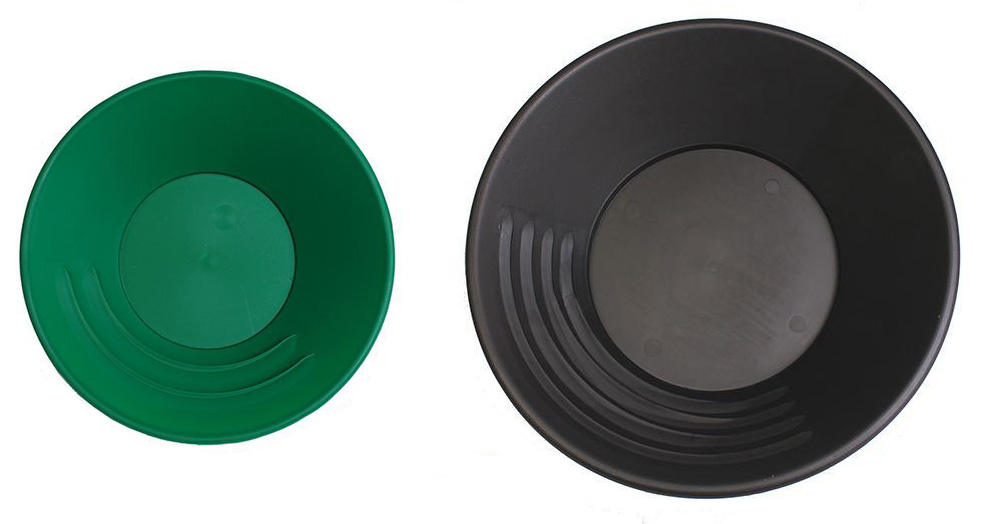
The point of panning is to shake the gravels, allowing the gold to settle downward and then to wash the lighter material off the top. When all the lighter material has been removed, only the heavy concentrates will remain in the bottom of the pan, including, hopefully, some gold! With a little practice, anyone can learn to pan for gold. Buying a bag of gold-bearing paydirt to use over and over again for practice in a tub is one way to get good at panning without ever leaving home. Gold panning “how to” steps founds here.
When outdoors in a stream digging gravels, remove big pebbles and stones from your pan before you begin. When looking for a place to pan, look for cracks and crevices in the bedrock of a stream (bedrock is a general term for the solid rock that sits under all sand and gravel) because gold can get caught and accumulate in cracks. Gold moves during periods of flooding and can drop out of fast-moving water into crevices. Mossing for gold is another technique that is easy to do with a pan. The green moss that grows on rocks near the edge of a stream often has a surprising capacity to catch and hold fine-sized gold. It’s almost like the matting on the bottom of a sluice (often called “miner’s moss”). Gold can get caught in the tendrils and structure of the moss and while the gold recovered from moss is tiny, sometimes there is a significant amount of it. Take the moss off the rocks from a spot close to the stream and at a level where, when the stream is in flood stage, the moss will be underwater. Carefully peel the moss off the rocks, breaking it up and washing out all the sand and silt. The material recovered from the moss can then be carefully panned out.
Gold concentrations are spotty, even in known gold-bearing areas, so sample and test often. Be sure to move on with your gold pan and don’t stay in one spot less you have good results. If you find a spot with fairly large amounts of gravel that yields good gold, then it’s time to bring in a sluice box. A sluice is simple to operate and have been used all across the world for thousands of years. After you’ve mastered gold panning and are ready to increase the amount of gravel you can process, a sluice box is your next step up from hand panning. Sluices come in a variety of sizes, most with gold-catching matting in the bottom that you need to clean up at the end of the day. Other models such as the Gold Well Vortex Drop Riffle Sluice, has no matting or carpets and uses vortex technology to catch fine gold.
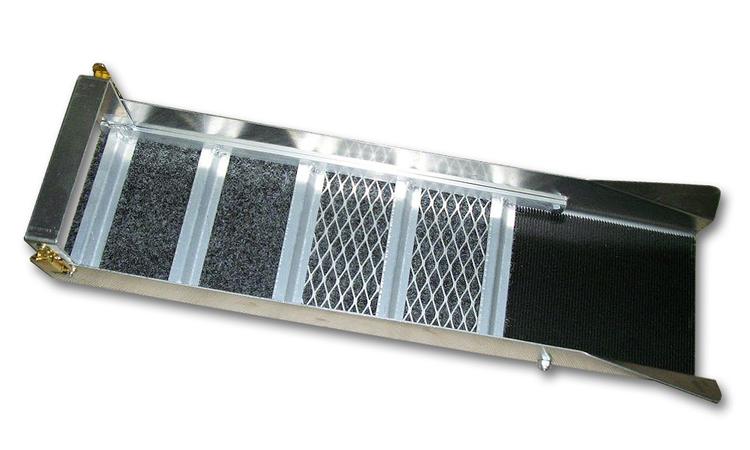 The basic sluice box is set in a stream and runs off the natural flow of water in the rivers. An experienced prospector might be able to pan up to a cubic yard of gravel per day, yet you can run that same cubic yard of gravel through a sluice box in less than an hour. Surface flood-type gold or gravel bars on inside bends of streams can both be very productive with just a simple sluice. It’s not too difficult to operate because it is fairly forgiving of the surges of gravel that drop in with each shovel full. To work properly, a sluice needs a good amount of water. The simple rule is just enough water flow should be going in the feed gravels to move the material through and out of the sluice in a reasonable time, allowing only a little of the heavier materials to build up behind the riffles. With too little water, the incoming material simply piles up as the rocks stop and get stuck in the sluice box. If the flow is too fast, fine gold will be blown out with the gravels. The optimum water flow is just what it takes to keep things clear in a reasonable time — no more than 20 or 30 seconds. The riffles should not become fully buried, with the entire bed of the sluice blanketed over by gravel. For maximum recovery, the flow should be a little turbulent, yet not frothy in any way. Excessive turbulence results in poor fine gold recovery. The basic sluice box is set in a stream and runs off the natural flow of water in the rivers. An experienced prospector might be able to pan up to a cubic yard of gravel per day, yet you can run that same cubic yard of gravel through a sluice box in less than an hour. Surface flood-type gold or gravel bars on inside bends of streams can both be very productive with just a simple sluice. It’s not too difficult to operate because it is fairly forgiving of the surges of gravel that drop in with each shovel full. To work properly, a sluice needs a good amount of water. The simple rule is just enough water flow should be going in the feed gravels to move the material through and out of the sluice in a reasonable time, allowing only a little of the heavier materials to build up behind the riffles. With too little water, the incoming material simply piles up as the rocks stop and get stuck in the sluice box. If the flow is too fast, fine gold will be blown out with the gravels. The optimum water flow is just what it takes to keep things clear in a reasonable time — no more than 20 or 30 seconds. The riffles should not become fully buried, with the entire bed of the sluice blanketed over by gravel. For maximum recovery, the flow should be a little turbulent, yet not frothy in any way. Excessive turbulence results in poor fine gold recovery.
As with the pan, the real secret of successful prospecting is not in operating the equipment, but in the skill of finding those natural gold catches. Learning to read the river or stream and recognize the places where gold might accumulate and then sampling those places to see if you are correct is the best technique. Inside bends, behind boulders or bedrock outcrops, and inches above the stream flow are all good places that you might sample, but there are plenty of other possibilities as well. The sluice and the gold pan may be among the most basic prospecting tools, but they are tried and true ways of finding some good gold!
Friday, February 19 2021
There are many interesting facts about the element gold, which is listed on the periodic table as Au. Au—comes from the old Latin  name for gold, aurum, which means "shining dawn" or "glow of sunrise." The word gold comes from the Germanic languages, originating from the Proto-Germanic gulþ and Proto-Indo-European ghel, meaning "yellow/green." The Aztec word for gold, "teocuitatl," translates to "excrement of the gods." Its atomic number is 79. name for gold, aurum, which means "shining dawn" or "glow of sunrise." The word gold comes from the Germanic languages, originating from the Proto-Germanic gulþ and Proto-Indo-European ghel, meaning "yellow/green." The Aztec word for gold, "teocuitatl," translates to "excrement of the gods." Its atomic number is 79.
A few more fun and fascinating facts about gold include:
- Gold is the most malleable element. A single ounce of gold (about 31 grams) can be stretched into a gold thread 5 miles long and beaten into a 300-square-foot sheet. A sheet of gold can be made thin enough to be transparent. You could even scratch pure gold with a fingernail.
- A karat is a unit of purity. And the karat number will determine the amount of gold in a particular piece. It is measured on a scale from eight to 24 in increments of two, with the higher number representing greater purity. However, almost nothing is pure gold or, 24 karats, with jewelry topping out at 22 karats. That’s because typically, when crafting gold jewelry, the gold must be mixed with another metal, such as copper or silver to make it usable.
- Gold is a pure element and is the only truly yellow metal on Earth. Other metals may develop a yellowish color, but only after they have oxidized or reacted with other chemicals.
- Gold has been found on all seven continents, but the first gold discovered in the United States was in 1799. A boy, Conrad Reed, found a 17-pound nugget in Cabarrus County North Carolina and used it as a door stop! This discovery happened 50 years prior to the famous California Gold Rush of 1849.
- Nearly all the gold on Earth came from meteorites that bombarded the planet over 200 million years after it formed.
- Gold’s melting point is 1,947ºF or 1,064 °C. Gold boils at 2,850°C. Small gold melting kilns are used by hobbyists.
- Olympic gold medals were pure gold until 1912. Currently, they're made up of 494 grams of silver and only 6 grams of gold.
- Fort Knox contains around 50% of the United States’ gold reserves. It has never been robbed. In fact, no one has even attempted carrying out such an operation. With 30,000 soldiers, a surrounding minefield, Predator drones doing routine surveillance, and 20-ton vault doors (which no single person has a combination to), it’s an impossible undertaking.
- Gold can be consumed in small quantities and is often added to luxury beverages and foods, but it has no known nutritional or taste value. It is considered biologically inert, which means that it can be digested without being absorbed or interacting with your body.
- If all of the world’s gold that has ever been mined were collected, it would fill three Olympic-sized swimming pools— each 164 x 82 feet x 6 feet deep— a combined 157,000 metric tons.
- Gold is the most popular precious metal for investments. The price of gold constantly fluctuates and is often linked to major economic events. Generally, the value of gold tends to move inversely to the value of the US dollar. For example, when the value of a dollar increases, the price of gold drops as it is relatively more expensive for those in other countries to purchase. The opposite is likewise true.
- Gold panning is fun for the whole family. You can even buy Alaskan paydirt and have it shipped to your home.
- Aurophobia is the fear of gold. And probably no one reading this has ever been diagnosed with that condition! Gold fever, however, is another story!
|









 for over a decade now, viewers have been enlightened and entertained by Gold Rush, Bering Sea Gold, White Water, and a couple of newer shows— Dave Turin's Lost Mine and Freddy Dodge's Mine Rescue. Although they’re off the air now, Under the Ice and Jungle Gold also captured attention a few years back. Aussie Gold Hunters is also interesting, and takes place in Western Australia.
for over a decade now, viewers have been enlightened and entertained by Gold Rush, Bering Sea Gold, White Water, and a couple of newer shows— Dave Turin's Lost Mine and Freddy Dodge's Mine Rescue. Although they’re off the air now, Under the Ice and Jungle Gold also captured attention a few years back. Aussie Gold Hunters is also interesting, and takes place in Western Australia. 






